Overview
The distinction between join and merge is pivotal in data manipulation. Joins are specifically designed to combine rows from multiple tables based on common fields, providing a straightforward approach to data integration. In contrast, merges encompass a broader range of methods for integrating datasets, offering enhanced flexibility. This article elucidates that joins are predominantly utilized in relational databases for simple combinations. Merges, particularly in programming environments such as Python’s Pandas, facilitate more complex integrations based on multiple keys or indices. This capability significantly enhances the potential for nuanced data analysis, inviting professionals to consider how they can leverage these techniques in their own work.
Introduction
In the intricate realm of data manipulation, the terms “join” and “merge” often lead to confusion; however, they signify distinct operations that are critical for effective analysis.
- Joins primarily focus on combining rows from multiple tables based on shared columns.
- Merges encompass a broader spectrum of data integration methods, including concatenation and conditional merging.
Understanding these nuances is essential for data professionals striving to derive actionable insights and uphold data integrity. As organizations increasingly depend on data-driven decision-making, the ability to navigate the complexities of joins and merges becomes paramount. This capability influences the choice of techniques and tools that drive operational efficiency and foster innovation.
This article delves into the definitions, applications, and best practices surrounding join and merge operations, equipping readers with the knowledge necessary to enhance their data analysis capabilities in a rapidly evolving landscape.
Understanding Join and Merge: Definitions and Context
In the realm of information manipulation, the terms ‘join’ and ‘merge’ are often used interchangeably. However, recognizing the difference between join and merge is crucial, as they possess distinct meanings that vary based on context. A ‘join’ specifically refers to the operation of combining rows from two or more tables based on a related column, a fundamental concept in SQL databases. For instance, an inner join retains only those records with matching values in the specified columns, such as rep_id and sales_rep_id, ensuring that only relevant information is included in the evaluation.
Conversely, ‘merge’ is a broader term that encompasses various methods of combining datasets. This includes merges, concatenation, and other forms of integration. The significance of understanding these definitions cannot be overstated, as they provide the foundation for more complex operations and optimizations in analysis.
Conditional merging is particularly useful when dealing with incomplete datasets that require unification, highlighting the practical implications of these definitions.
The difference between join and merge becomes especially apparent when considering their applications. A case study titled ‘Practices That Ensure Smooth Merging‘ outlines the complexities involved in merging and provides best practices to ensure a seamless process. It emphasizes the necessity of evaluating information sources and ensuring unique variables before merging, ultimately leading to a reliable single source of truth for analytics.
This aligns with the principles of Business Intelligence, which seeks to transform raw information into actionable insights, enabling informed decision-making that drives growth and innovation.
Current definitions from authoritative sources reinforce the notion that joins are specific to relational databases, whereas merges can apply to a broader range of manipulation scenarios. This distinction is vital for experts examining information, as it affects the selection of methods and tools employed to extract insights. Furthermore, leveraging Robotic Process Automation (RPA) to automate manual workflows can enhance operational efficiency, allowing teams to focus on strategic, value-adding activities.
Expert opinions further clarify that a solid grasp of these concepts is essential for effective information management and examination, enabling organizations to navigate the rapidly evolving AI landscape. As Abhinav Sai Penmetsa aptly states, “Share this article with anyone interested in data engineering, Python, or information assessment,” emphasizing the importance of these concepts in the wider knowledge landscape. Grasping these techniques corresponds with our organization’s distinctive value in improving information quality and streamlining AI implementation, ultimately boosting operational efficiency.
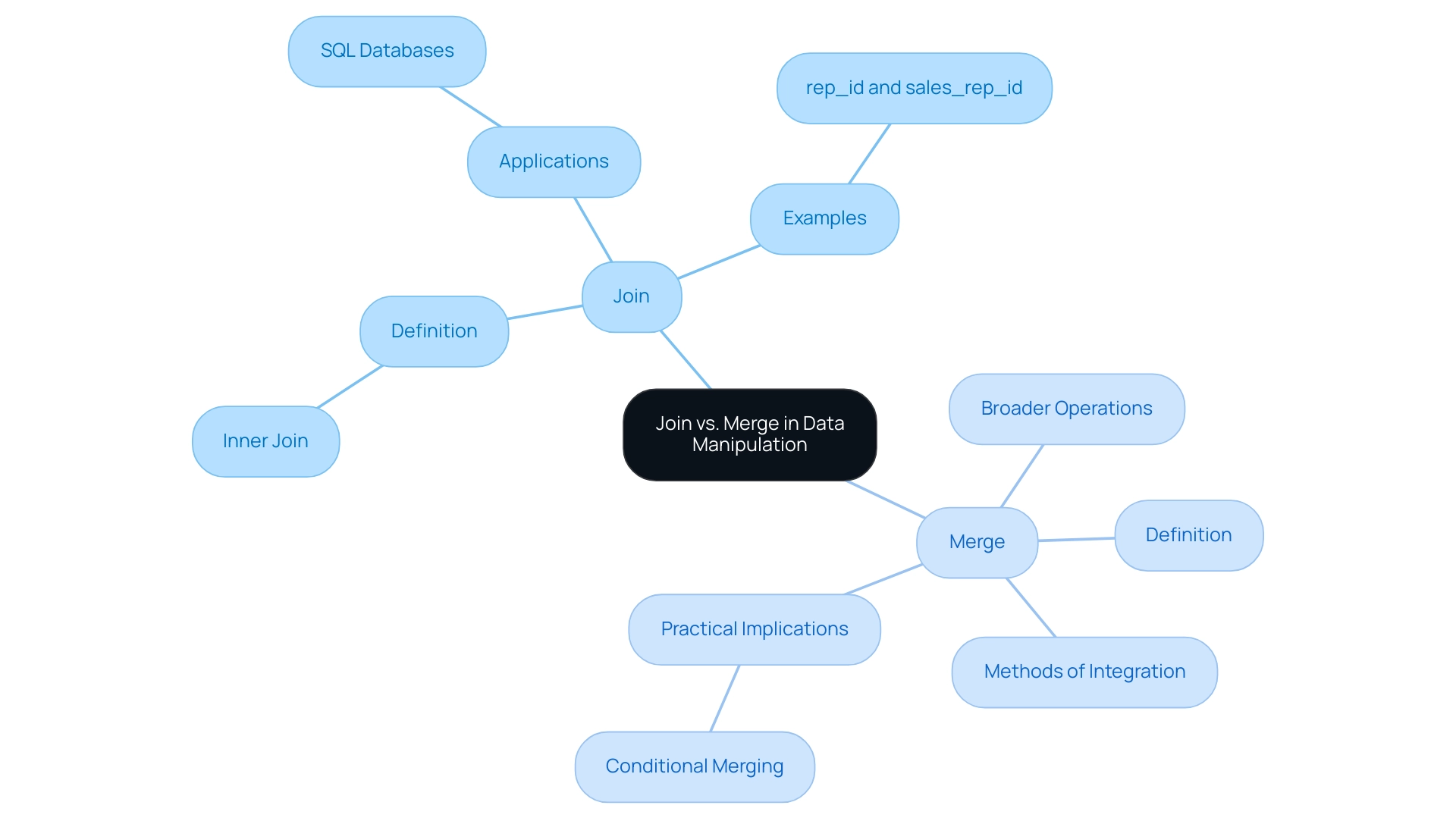
Key Differences Between Join and Merge Operations
The fundamental difference between join and merge operations lies in their functionality and application within data analysis. Joins are primarily utilized to combine rows from two tables based on a common field, such as a foreign key. They can be classified into several types: inner connection, outer connection, left connection, and right connection.
For instance, an inner connection retrieves records that have matching values in both tables, while an outer connection includes all records from one table and the matched records from the other, filling in gaps with nulls where no match exists. Statistics indicate that inner connections are the most frequently utilized type in SQL databases, underscoring their significance in data retrieval and analysis.
In contrast, merge operations, particularly in programming languages like Python, offer greater flexibility. The merge() function in the Pandas library allows users to perform SQL-like connections, enabling the combination of datasets based on multiple keys or indices. This is particularly beneficial when handling intricate structures and relationships.
When combining two datasets that share multiple attributes, the merge() function can effectively align the information based on these common keys. In comparison, the join() method is more index-focused and usually employed for simpler situations.
Understanding these essential distinctions is vital for efficient analysis, particularly the difference between join and merge. Joins are often favored for their straightforward approach to combining tables, while merges provide the versatility needed for more complex information relationships. As data analyst Alakh Sethi aptly states, “Embrace the adaptability of SQL connections to effectively examine your information’s potential, transforming raw content into practical insight.”
By leveraging both joins and merges appropriately, analysts can optimize their workflows and drive informed decision-making.
Furthermore, incorporating Robotic Process Automation (RPA) into these information workflows can significantly enhance efficiency by automating repetitive tasks related to information preparation and analysis. This not only reduces mistakes but also enables teams to concentrate on strategic insights derived from information, thereby freeing them for more value-adding work. Additionally, the case study on utilizing plan guides for query optimization illustrates real-world applications of join and merge operations, showcasing how effective query design can enhance performance.
Moreover, the tailored AI solutions provided by Creatum GmbH improve information quality and streamline AI implementation, aligning with our primary objective of fostering growth and innovation in information examination.
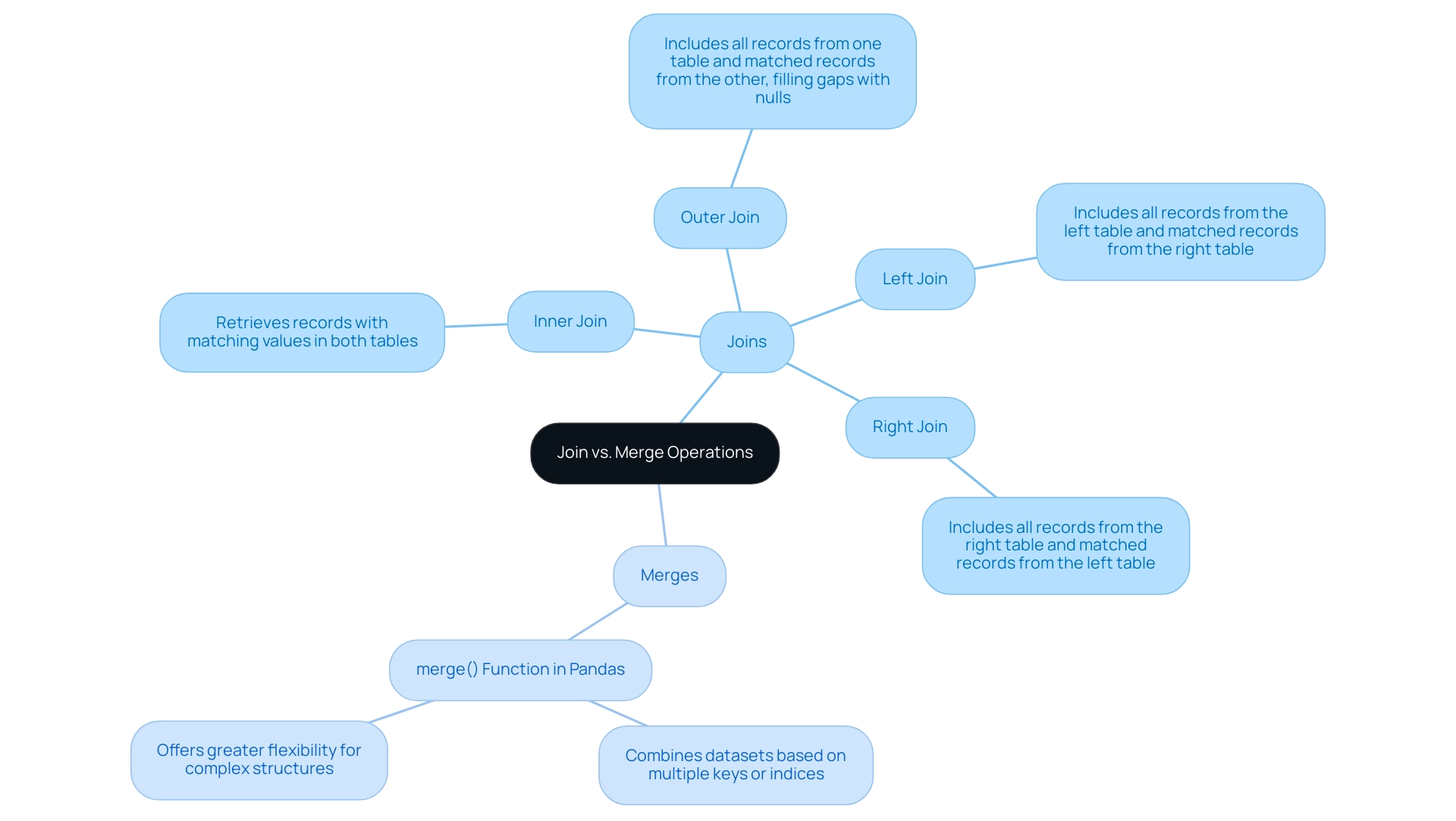
Methods of Joining and Merging in Programming Languages
In the realm of programming, particularly within manipulation libraries like Pandas in Python, mastering the methods for joining and merging information is essential for effective analysis. The merge() function in Pandas stands out for its robustness, allowing users to specify the columns for combination, thereby adapting to various data structures. For instance, employing df1.merge(df2, on='key') facilitates the seamless integration of two DataFrames based on a shared key, enabling deeper insights from disparate information sources.
This capability is crucial in a data-rich environment where extracting meaningful insights can significantly influence business growth and innovation.
Conversely, the join() method is primarily used for joining DataFrames based on their indices. This approach can streamline operations when the index serves as the primary key, making it a straightforward option for numerous information manipulation tasks. Understanding the distinction between join and merge techniques is vital for data scientists and analysts as they navigate complex information sets, particularly when insufficient master data quality can impede effective evaluation.
As noted by Mirko Stojiljković, a university professor, ‘In the age of extensive information and artificial intelligence, you must know how to compute descriptive statistics measures,’ underscoring the essential skills necessary for effective examination. Statistics reveal that the frequency of the tenth bin in information evaluation is 15, highlighting the importance of precise information manipulation techniques. This statistic emphasizes the need for meticulous methods in information handling, as even minor discrepancies can lead to significant errors in analysis.
Furthermore, case studies indicate that organizations overwhelmed by data have successfully transformed raw information into actionable insights through effective business intelligence strategies, enhancing data quality and driving growth. Notably, Siavoshi, who has taught university courses in biostatistics and machine learning, provides valuable insights into the application of these techniques in real-world scenarios, demonstrating how tailored AI solutions can cut through the noise of overwhelming options.
When comparing the merge() function and the combine() method, performance statistics must also be considered. The merge() function is often preferred for its flexibility, while the join() method can be more efficient in specific scenarios, particularly when dealing with large datasets. Additionally, understanding the median_low() and median_high() functions, which return the lower and higher middle values for even-numbered datasets, respectively, can further enhance manipulation capabilities.
By effectively leveraging these methods, analysts can unlock the full potential of their information, leading to informed decision-making and strategic advancements, ultimately driving operational efficiency and business growth.
At Creatum GmbH, our RPA solutions complement these information manipulation techniques, addressing task repetition fatigue and enhancing operational efficiency. By integrating RPA with information evaluation, organizations can boost employee morale and optimize processes, ensuring that insights based on evidence translate into concrete business outcomes.
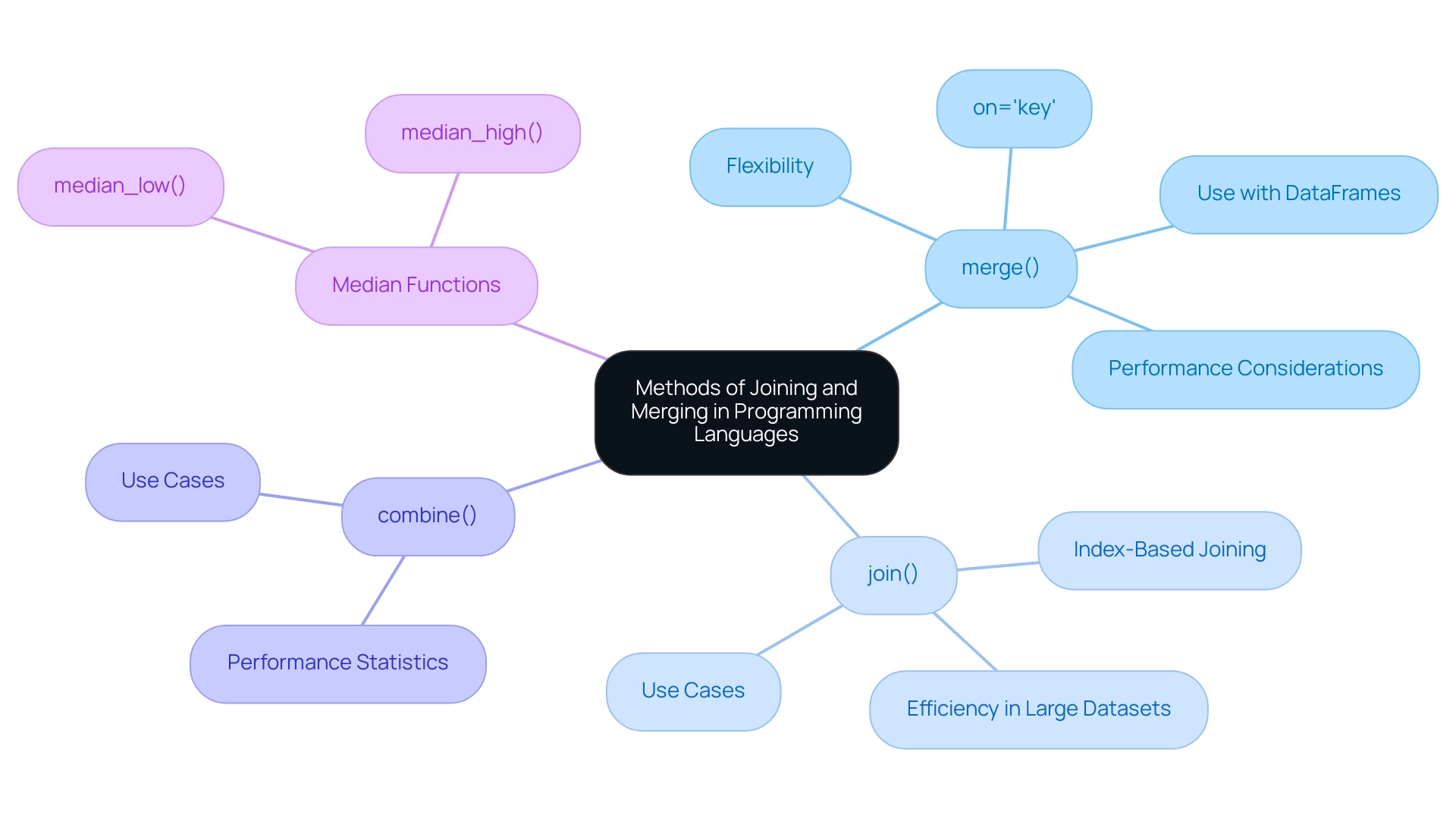
Practical Use Cases: When to Use Join vs. Merge
Choosing between methods necessitates a clear understanding of the distinction between join and merge—an essential aspect that often hinges on the specific requirements of the analysis task. For instance, when merging datasets based on a shared identifier, such as customer IDs, an inner connection emerges as the optimal choice. This operation effectively returns only the records with matching values across both datasets, thereby ensuring integrity and relevance.
Conversely, in scenarios involving time series data where indices represent dates, employing the combine() method can yield greater benefits. This strategy aligns data according to the index, thus eliminating the need for additional key specifications and streamlining the entire process.
To illustrate these concepts, consider the case study of Toyota’s Sales Data Integration. The goal was to merge Sales Representatives Data with Toyota Sales Data, facilitating the calculation of total sales by each representative. This integration not only provided valuable insights into sales performance but also empowered informed decision-making, underscoring the significance of Business Intelligence in driving data-driven insights and enhancing operational efficiency for business growth.
Industry experts emphasize the necessity of grasping the difference between join and merge when determining how to combine operations. For example, an inner join is recommended when the focus is on matching records. It is equally crucial to recognize the distinction between join and merge when aligning datasets based on their indices. By understanding these practical applications, professionals can enhance their analytical efficiency and achieve superior outcomes in their projects.
Moreover, leveraging Robotic Process Automation (RPA) can significantly boost operational efficiency in information examination by automating manual workflows, thus allowing teams to concentrate on strategic tasks. Tailored solutions that enhance information quality and streamline AI implementation are vital for maximizing these efficiencies. As Abhinav Sai Penmetsa aptly states, “Share this article with anyone interested in engineering, Python, or analysis,” highlighting the relevance of these concepts within the broader context of data-driven decision-making.
Furthermore, consider how commission calculations—where commission earned is determined by multiplying the sale amount by the commission percentage—can be effectively analyzed using join or merge techniques to derive meaningful insights from financial information.
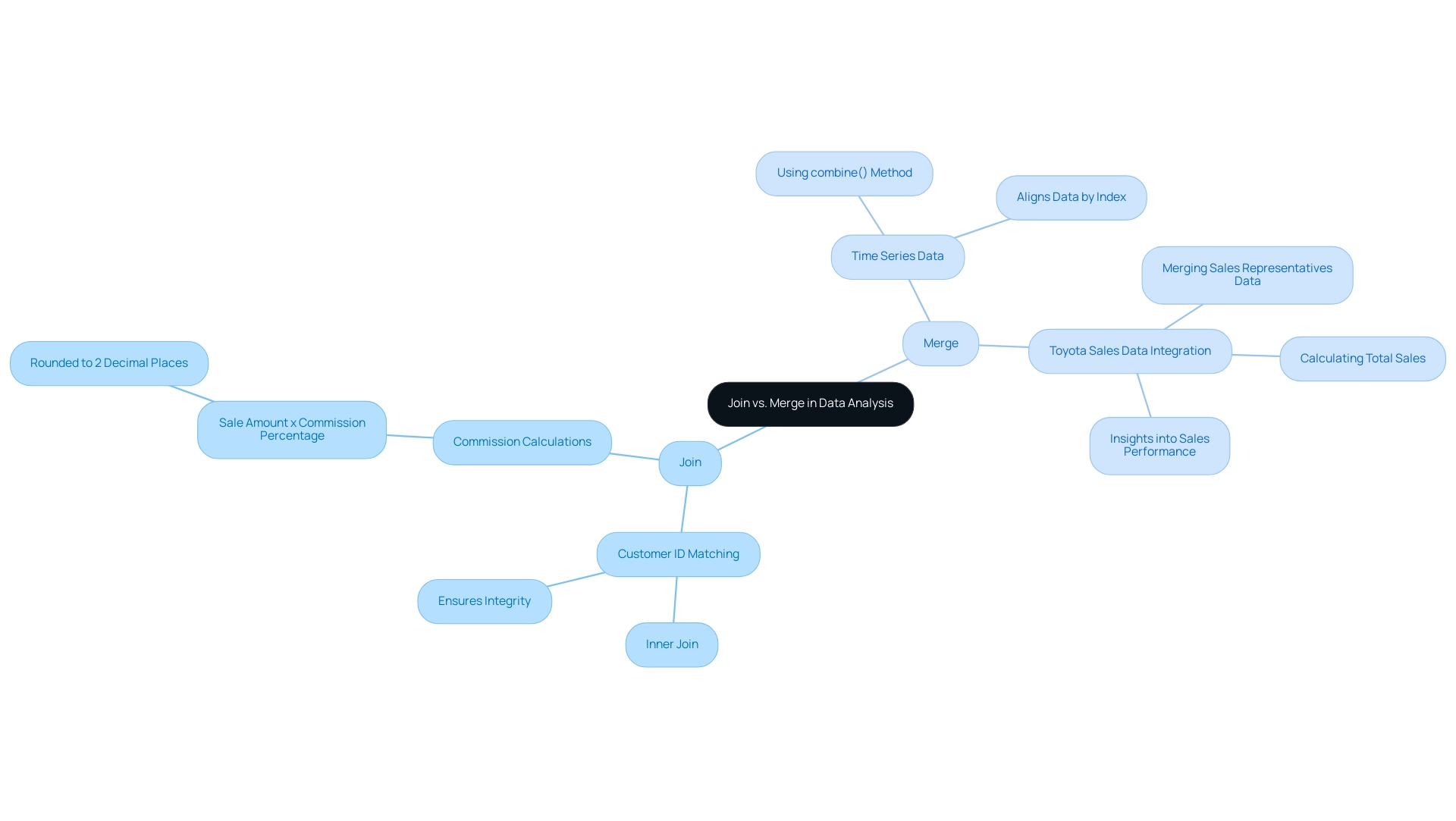
Challenges and Pitfalls in Join and Merge Operations
Understanding the distinction between join and merge operations is crucial for effective information manipulation; however, these operations present challenges that can significantly impact data quality. A common issue arises from the oversight of duplicate keys, which can inflate row counts and distort analysis outcomes. For example, a case study titled ‘Business Intelligence Empowerment’ demonstrates how neglecting duplicate keys led to inaccurate insights, ultimately affecting decision-making processes.
This case underscores the critical importance of maintaining quality in analytics, especially when leveraging Business Intelligence to drive informed decision-making and enhance operational efficiency.
Moreover, improper handling of missing values presents another substantial risk. Utilizing an outer join without a clear strategy for addressing missing information can lead to misleading conclusions. Notably, statistics indicate that setting the index before merging can enhance processing speed by up to 30 times, highlighting the efficiency gains associated with proper information handling practices.
Robotic Process Automation (RPA) can play a pivotal role in this context, streamlining repetitive tasks and enabling teams to concentrate on strategic analysis rather than manual corrections.
To navigate these pitfalls, implementing robust validation checks is essential. Professionals emphasize that understanding the difference between join and merge is vital for preserving the integrity of the resulting dataset. As Durga Gadiraju aptly states, ‘We welcome your feedback and questions — let’s make this a collaborative learning experience!’
By prioritizing information quality and employing strategic methods to connect and combine processes, organizations can transform raw information into actionable insights, driving growth and innovation. Furthermore, a comprehensive processing pipeline example can illustrate these concepts effectively, demonstrating how to load CSV files, merge information, fill missing values, calculate commission earned, and group sales by rep, ultimately enhancing operational efficiency and supporting insights driven by information.
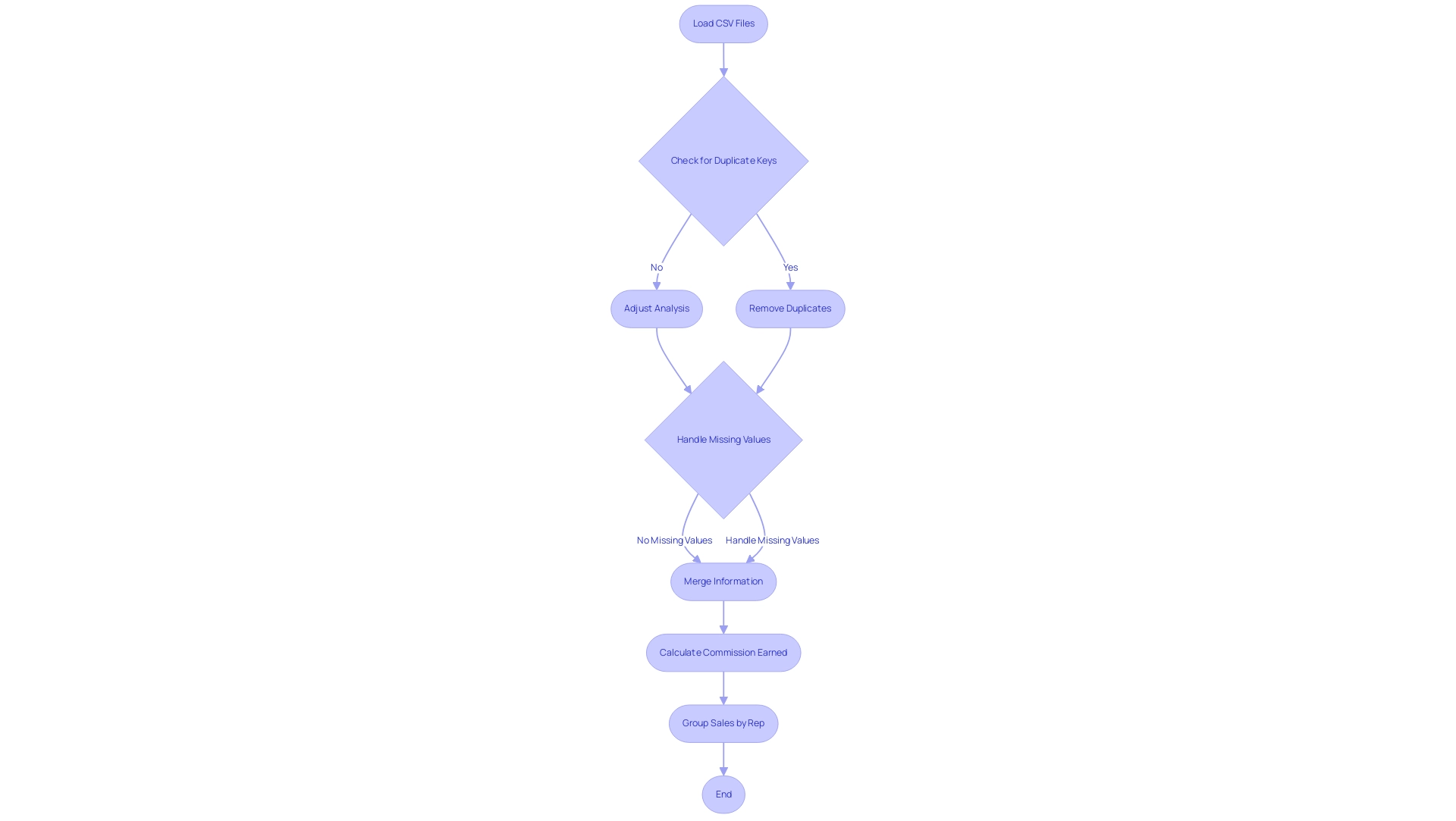
Best Practices for Efficiently Using Join and Merge
To enhance the efficiency of combining and merging tasks, understanding the difference between join and merge is crucial. Indexing the keys used for joining can lead to significant performance improvements. Research indicates that appropriately indexed connection keys can reduce query execution time by as much as 70%. This step is essential in optimizing data operations.
Next, the selection of connection type plays a vital role in performance. For instance, choosing an inner combination when only matching records are required minimizes the size of the resulting dataset, thus enhancing processing speed. Moreover, employing the merge() function in Pandas is advisable for more intricate operations due to its flexibility in specifying connection conditions and managing various structures.
It is also essential to verify the outcomes of your combinations and merges to ensure integrity and precision. This verification not only confirms that the information aligns with expectations but also aids in identifying discrepancies early in the process. As Randy aptly states, “ALWAYS ALWAYS favor normalization,” underscoring the importance of preserving organized information for efficient connections.
Real-world applications, such as the case study on Impala, illustrate the importance of these practices. In scenarios where table or column statistics are unavailable, using the STRAIGHT_JOIN keyword can prevent Impala from reordering joined tables, thus maintaining the specified join order for optimal performance. This approach is particularly beneficial in complex queries where performance tuning is necessary.
Furthermore, leveraging tools like ClicData, which offers over 250+ connectors, simplifies the joining process for both beginners and experts. The platform’s capabilities for automated updates and scheduling for ETL processes further emphasize the importance of efficiency in operations. By incorporating Robotic Process Automation (RPA) into these workflows, organizations can automate repetitive tasks, enhancing efficiency, decreasing errors, and freeing up resources for more strategic evaluation and decision-making.
In summary, by applying these best practices—indexing keys, choosing suitable connection types, leveraging Pandas to comprehend the difference between join and merge in complex merges, and validating results—organizations can significantly enhance the efficiency and precision of their analysis processes. Tailored solutions that improve information quality and simplify AI implementation are essential for fostering growth and innovation in today’s information-rich environment. This ultimately supports informed decision-making and operational efficiency. At Creatum GmbH, we are committed to providing tailored AI solutions that address your specific business challenges.

Summary of Key Takeaways on Join and Merge
Understanding the difference between join and merge operations is vital for proficient information manipulation, particularly in enhancing operational efficiency through Robotic Process Automation (RPA). Joins are primarily employed to combine datasets based on shared fields, whereas merges offer greater flexibility for managing complex structures. By comprehending the appropriate contexts for each approach, along with their potential drawbacks and optimal techniques, professionals can significantly improve operational efficiency and achieve accurate information evaluation.
Mastery of these concepts is essential for effectively leveraging information in decision-making processes and integrating RPA solutions that minimize errors and free up team resources.
Key takeaways for professionals include:
- Joins are best for straightforward combinations of datasets, while merges are suited for more complex scenarios.
- Recognizing the difference between join and merge in each function can prevent common errors and enhance information integrity, which is crucial when implementing RPA.
- Practical application of these techniques can significantly streamline workflows and reduce preparation time, aligning with the goals of operational efficiency.
For instance, a recent tutorial on cleaning messy information from an Excel sheet containing popular baby names in England and Wales illustrated the importance of these techniques. By importing, filtering, and rearranging information, users learned how to effectively prepare datasets for evaluation, showcasing the real-world impact of understanding the difference between join and merge techniques. Notably, the tally of the most favored baby name ‘THOMAS’ was 4,075, underscoring the importance of precise information handling in obtaining valuable insights.
Statistics indicate that grasping these processes can lead to enhanced information quality and more enlightening analyses, ultimately fostering growth and innovation in information-driven settings. Customized solutions enhance information quality and simplify AI implementation, enabling professionals to apply these techniques effectively. Therefore, understanding the difference between join and merge operations is not merely beneficial but essential for data professionals aiming to excel in their roles and leverage RPA for enhanced operational efficiency in a rapidly evolving AI landscape.

Conclusion
Understanding the differences between join and merge operations is crucial for effective data manipulation and analysis. Joins focus on combining datasets based on shared fields, making them ideal for straightforward data combinations. In contrast, merges offer greater flexibility, accommodating more complex data structures and relationships. Recognizing when to employ each method can significantly enhance data integrity and operational efficiency, particularly in the context of leveraging Robotic Process Automation to streamline workflows.
The key takeaways emphasize the importance of mastering these techniques to prevent common pitfalls, such as overlooking duplicate keys or improperly handling missing values. By adhering to best practices—such as indexing keys, selecting appropriate join types, and validating results—data professionals can optimize their analysis processes, reduce errors, and free up resources for more strategic tasks.
Real-world applications, such as case studies demonstrating the integration of diverse datasets for actionable insights, reinforce the necessity of these skills in today’s data-driven landscape. Ultimately, achieving proficiency in join and merge operations is not merely advantageous; it is essential for driving growth and innovation, enabling organizations to make informed decisions based on high-quality data.
Frequently Asked Questions
What is the difference between ‘join’ and ‘merge’ in data manipulation?
‘Join’ refers to the operation of combining rows from two or more tables based on a related column, primarily used in SQL databases. In contrast, ‘merge’ is a broader term that includes various methods of combining datasets, such as concatenation and other forms of integration.
Can you explain how an ‘inner join’ works?
An inner join retains only those records with matching values in the specified columns from the tables being joined, ensuring that only relevant information is included in the evaluation.
What are some types of joins?
Joins can be classified into several types, including inner connection, outer connection, left connection, and right connection, each serving different purposes in data retrieval.
How does the ‘merge’ function in programming languages like Python differ from ‘join’?
The ‘merge()’ function in Python’s Pandas library offers greater flexibility, allowing users to combine datasets based on multiple keys or indices, whereas the ‘join()’ method is more index-focused and typically used for simpler situations.
Why is understanding the difference between join and merge important?
Understanding these distinctions is vital for efficient data analysis, as it affects the selection of methods and tools used to extract insights, optimizing workflows and driving informed decision-making.
What role does conditional merging play in data analysis?
Conditional merging is particularly useful when dealing with incomplete datasets that require unification, highlighting the practical implications of understanding the definitions of join and merge.
How can Robotic Process Automation (RPA) enhance data workflows?
RPA can automate repetitive tasks related to information preparation and analysis, reducing mistakes and allowing teams to focus on strategic insights, thus enhancing operational efficiency.
What resources can provide further insights into the complexities of merging data?
A case study titled ‘Practices That Ensure Smooth Merging‘ outlines the complexities involved in merging and provides best practices for a seamless process, emphasizing the necessity of evaluating information sources before merging.
